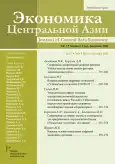Reduction of imbalances in the development of Uzbek regions based on the assessment of economic growth factors
- Authors: Aimbetov N.K.1, Kuryozov D.I.1
-
Affiliations:
- Karakalpak Scientific Research Institute of Natural Sciences of the Karakalpak Branch of the Academy of Sciences of Uzbekistan
- Issue: Vol 7, No 3 (2023)
- Pages: 191-206
- Section: Articles
- URL: https://journals.eco-vector.com/2542-0607/article/view/625017
- DOI: https://doi.org/10.18334/asia.7.3.119573
- ID: 625017
Cite item
Abstract
The article discusses the indicators used in monitoring regional development imbalances in the USA, China, Japan, the UK, and the EU countries, as well as the specifics of regional policy to eliminate them. Generalization of foreign experience made it possible to identify priority areas that need to be taken into account when implementing programs to reduce the disproportions in the level of development of Uzbek regions. Methodological approaches to assessing the level of socio-economic development of the regions of the republic are studied. According to the specific indicators of the gross regional product, the volume of industrial production, investments in fixed assets, and real total income per capita, an analysis of the differentiation of regions for 2018-2022 is carried out. Diagnostics of the factors of economic growth made it possible to identify the main problems that negatively affect the level of development of depressed regions of Uzbekistan. In order to align the territorial structure of the republic\'s economy, new mechanisms of regional development are considered, based on conditions, potential and opportunities, as well as further improvement of the business environment, improvement of the procedure for providing state support and increasing its effectiveness.
About the authors
Nagmet Kallievich Aimbetov
Karakalpak Scientific Research Institute of Natural Sciences of the Karakalpak Branch of the Academy of Sciences of Uzbekistan
Email: nagmet55@mail.ru
Dilshod Ismailovich Kuryozov
Karakalpak Scientific Research Institute of Natural Sciences of the Karakalpak Branch of the Academy of Sciences of Uzbekistan
References
- Стратегия развития Нового Узбекистана на 2022-2026 гг. Приложение № 1 к Указу Президента Республики Узбекистан от 28 января 2022 года № УП-60 // Национальная база данных законодательства, 29.01.2022 г., № 06/22/60/0082
- Указ Президента Республики Узбекистан от 30 декабря 2022 года №УП-287 // Национальная база данных законодательства, 30.12.2022 г., № 06/22/287/1140
- Асадов Х.С. Современные тенденции экономического развития регионов Узбекистана // Экономика. – 2020. – № 3. – c. 251-262. – doi: 10.18334/asia.4.3.110805.
- Мамадалиева Э.Р. Диагностика уровня социально-экономического развития регионов Узбекистана // Россия: тенденции и перспективы развития: Ежегодник: материалы XX Национальной научной конференции с международным участием. Том Выпуск 16. Часть 1. Москва, 2021. – c. 1028-1031.
- Мирзиёева С.Ш. Совершенствование методологии разработки и реализации региональных социально-экономических стратегий (на материалах Республики Узбекистан. / Автореф. дисс. кан. экон. наук. - М., 2021. – 26 c.
- Миронова Т.Л. Зарубежный опыт преодоления социально-экономической дифференциации регионов // Ученые записки Таврического национального университета им. В.И. Вернадского. – 2008. – № 1-2. – c. 139-145.
- Самбурова Е.Н. Региональные диспропорции современного развития экономики Китая // Вестник Московского университета. Серия 5: География. – 2014. – № 4. – c. 49-55.
- Серединская К.С. Региональная политика Испании: социально-экономические аспекты. / дисс. кан. экон. наук. - М., 2018. – 193 c.
- Толстова М.Л. Особенности стратегического финансового планирования регионального развития в зарубежных странах // Вестник экономики, права и социологии. – 2011. – № 4. – c. 131-135.
- Уткин Э.А., Денисов А.Ф. Государственное и региональное управление. - М.: ИКФ «ЭКМОС», 2002. – 320 c.
- Хазраткулова Л.Н. Совершенствование межбюджетных отношений в Республике Узбекистан. / Автореф. дисс. д-ра филос. (PhD) по экон. наукам. - Ташкент, 2020. – 70 c.
- Governing Regional Development Policy: the use of performance indicators. - Paris: OECD, 2009. – 198 p.
- Halkier H., Danson M., Dambor C. Regional development agencies in Europe. - London: Jessica Kingsley, 1998. – 374 p.
Supplementary files









